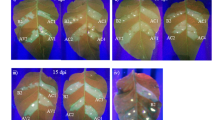Abstract
The Arabidopsis gene AINTEGUMENTA (At-ANT) functions in cell proliferation and organ growth. The ANT protein has two copies of the AP2 domains, R1 and R2. Recently, a partial cDNA sequence of the At-ANT homolog in Antirrhinum majus (Am-ANT) was reported (Delgado-Benarroch et al., 2009). Here, we used virus-induced gene silencing (VIGS) to analyze the function of the reported Am-ANT. We then determined the open reading frame (ORF) of Am-ANT and its predicted amino acid sequence. We induced VIGS using the Cucumber mosaic virus vector (CMV-A1) that contained partial sequence of Am-ANT (A1:ANT) and suppressed the level of Am-ANT mRNA and noted for any phenotypic changes. The function of Am-ANT was very similar to that of At-ANT. The A1:ANT-infected Antirrhinum plants had smaller floral organs and leaves, even though cell sizes were unchanged in flowers and larger in leaves. The CMV-based VIGS showed that the isolated Am-ANT gene was indeed functional in cell proliferation and organ growth as observed for At-ANT. In conclusion, we found that the CMV vector had the advantage of systemically infecting A. majus without severe symptoms for functional analysis of A. majus genes.
Similar content being viewed by others
Literature Cited
Baker, S.C., K. Robinson-Beers, J.M. Villanueva, J.C. Gaiser, and C.S. Gasser. 1997. Interactions among genes regulating ovule development in Arabidopsis thaliana. Genetics 145:1109–1124.
Burch-Smith, T.M., J.C. Anderson, G.B. Martin, and S.P. Dinesh-Kumar. 2004. Applications and advantages of virusinduced gene silencing for gene function studies in plants. The Plant J. 39:734–746.
Darwin, C.R. 1868. Variation of animals and plants under domestication. John Murray, London.
Delgado-Benarroch, L., B. Causier, J. Weiss, and M. Egea-Cortines. 2009. FORMOSA controls cell division and expansion during floral development in Antirrhinum majus. Planta 229:1219–1229.
Elliott, R.C., A.S. Betzner, E. Huttner, M.P. Oakes, W.Q. Tucker, D. Gerentes, P. Perez, and D.R. Smyth. 1996. AINTEGUMENTA, an APETALA2-like gene of Arabidopsis with pleiotropic roles in ovule development and floral organ growth. Plant Cell 8:155–168.
Goto, K., A. Kanazawa, M. Kusaba, and C. Masuta. 2003. A simple and rapid method to detect plant siRNAs using nonradioactive probes. Plant Mol. Biol. Rep. 21:51–58.
Hamilton, A.J. and D.C. Baulcombe. 1999. A species of small antisense RNA in posttranscriptional gene silencing in plants. Science 286:950–952.
Horiguchi, G., A. Ferjani, U. Fujikura, and H. Tsukaya. 2006. Coordination of cell proliferation and cell expansion in the control of leaf size in Arabidopsis thaliana. J. Plant Res. 119:37–42.
Hudson, A., J. Critchley, and Y. Erasmus. 2008. The Genus Antirrhinum (Snapdragon): A flowering plant model for evolution and development. Cold Spring Harb. Protoc. doi 10.1101/pdb.emo100.
Kim, B., C. Masuta, H. Matsuura, H. Takahashi, and T. Inukai. 2008. Veinal necrosis induced by Turnip mosaic virus infection in Arabidopsis is a form of defense response accompanying HR-like cell death. Mol. Plant-Microbe Interact. 21:260–268.
Klucher, K.M., H. Chow, L. Reiser, and R.L. Fischer. 1996. The AINTEGUMENTA gene of Arabidopsis required for ovule and female gametophyte development is related to the floral homeotic gene APETALA2. Plant Cell 8:137–153.
Krizek, B.A. 1999. Ectopic expression of AINTEGUMENTA in Arabidopsis plants results in increased growth of floral organs. Dev. Genet. 25:224–236.
Krizek, B.A. 2003. AINTEGUMENTA utilizes a mode of DNA recognition distinct from that used by proteins containing a single AP2 domain. Nucleic Acids Res. 31:1859–1868.
Mizukami, Y. and R.L. Fischer. 2000. Plant organ size control: AINTEGUMENTA regulates growth and cell numbers during organogenesis. Proc. Natl. Acad. Sci. U.S.A. 97:942–947.
Mizukami, Y. 2001. A matter of size: developmental control of organ size in plants. Curr. Opin. Plant Biol. 4:533–539.
Nagamatsu, A., C. Masuta, M. Senda, H. Matsuura, A. Kasai, J.S. Hong, K. Kitamura, J. Abe, and A. Kanazawa. 2007. Functional analysis of soybean genes involved in flavonoid biosynthesis by virus induced gene silencing. Plant Biotechnol. 5:778–790.
Nole-Wilson, S. and B.A. Krizek. 2000. DNA binding properties of the Arabidopsis floral development protein AINTEGUMENTA. Nucleic Acids Res. 28:4076–4082.
Otagaki, S., M. Arai, A. Takahashi, K. Goto, J.S. Hong, C. Masuta, and A. Kanazawa. 2006. Rapid induction of transcriptional and post-transcriptional gene silencing using a novel Cucumber mosaic virus vector. Plant Biotechnol. 23:259–265.
Preston, J.C. and L.C. Hileman. 2010. SQUAMOSA-PROMOTER BINDING PROTEIN 1 initiates flowering in Antirrhinum majus through the activation of meristem identity genes. The Plant J. 62:704–712.
Rieu, I., M. Bots, C. Mariani, and K.A.P. Weterings. 2005. Isolation and expression analysis of a tobacco AINTEGUMENTA ortholog (NtANTL). Plant Cell Physiol. 46:803–805.
Schneitz, K., M. Hülskamp, S.D. Kopczak, and R.E. Pruitt. 1997. Dissection of sexual organ ontogenesis: a genetic analysis of ovule development in Arabidopsis thaliana. Development 124:1367–1376.
Shang, Y., K.E. Schwinn, M.J. Bennett, D.A. Hunter, T.L. Waugh, N.N. Pathirana, D.A. Brummell, P.E. Jameson, and K.M. Davies. 2007. Methods for transient assay of gene function in floral tissues. Plant Methods 3:1.
Suzuki, M., S. Kuwata, J. Kataoka, C. Masuta, N. Nitta, and Y. Takanami. 1991. Functional analysis of deletion mutants of Cucumber mosaic virus RNA3 using an in vitro transcription system. Virol. 183:106–113.
Author information
Authors and Affiliations
Corresponding author
Additional information
These authors are contributed equally to this work.
Rights and permissions
About this article
Cite this article
Kim, B.M., Inaba, Ji. & Masuta, C. Virus induced gene silencing in Antirrhinum majus using the Cucumber mosaic virus vector: Functional analysis of the AINTEGUMENTA (Am-ANT) gene of A. majus . Hortic. Environ. Biotechnol. 52, 176–182 (2011). https://doi.org/10.1007/s13580-011-0172-y
Received:
Accepted:
Published:
Issue Date:
DOI: https://doi.org/10.1007/s13580-011-0172-y




